
In astronomy, a contact binary is a binary star system whose component stars are so close that they touch each other or have merged to share their gaseous envelopes. A binary system whose stars share an envelope may also be called an overcontact binary. The term "contact binary" was introduced by astronomer Gerard Kuiper in 1941. Almost all known contact binary systems are eclipsing binaries; eclipsing contact binaries are known as W Ursae Majoris variables, after their type star, W Ursae Majoris.
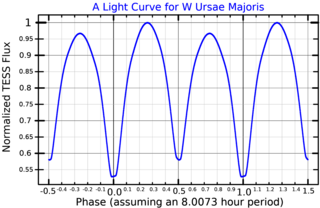
W Ursae Majoris is the variable star designation for a binary star system in the northern constellation of Ursa Major. It has an apparent visual magnitude of about 7.9, which is too faint to be seen with the naked eye. However, it can be viewed with a small telescope. Parallax measurements place it at a distance of roughly 169 light years (52 parsecs) from Earth.
Eta Ursae Majoris, formally named Alkaid, is a star in the constellation of Ursa Major. It is the most eastern (leftmost) star in the Big Dipper asterism. However, unlike most stars of the Big Dipper, it is not a member of the Ursa Major moving group. With an apparent visual magnitude of +1.84, it is the third-brightest star in the constellation and one of the brightest stars in the night sky.
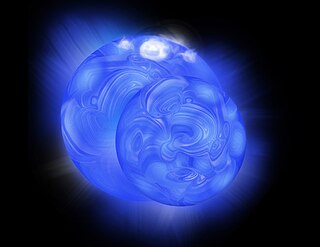
44 Boötis or i Boötis is a triple star system in the constellation Boötes. It is approximately 41.6 light years from Earth.

S Antliae is a W Ursae Majoris-type eclipsing binary star in Antlia.

Y Sextantis, abbreviated as Y Sex, is a variable star system in the equatorial constellation of Sextans. The system is invisible to the naked eye with a mean apparent visual magnitude of 9.88. It is located roughly at 1,300 light years from the Sun based on parallax.
Epsilon Coronae Australis, is a star system located in the constellation Corona Australis. Varying in brightness between apparent magnitudes of 4.74 to 5 over 14 hours, it is the brightest W Ursae Majoris variable in the night sky.

V1191 Cygni is the variable star designation for an overcontact binary star system in the constellation Cygnus. First found to be variable in 1965, it is a W Ursae Majoris variable with a maximum apparent magnitude 10.82. It drops by 0.33 magnitudes during primary eclipses with a period of 0.3134 days, while dropping by 0.29 magnitudes during secondary eclipses. The primary star, which is also the cooler star, appears to have a spectral type of F6V, while the secondary is slightly cooler with a spectral type of G5V. With a mass of 1.29 solar masses and a luminosity of 2.71 solar luminosities, it is slightly more massive and luminous than the sun, while the secondary is only around 1/10 as massive and less than half as luminous. With a separation of 2.20 solar radii, the mass transfer of about 2×10−7 solar masses per year from the secondary to the primary is one of the highest known for a system of its type.
SX Corvi is an eclipsing binary star system in the constellation Corvus, ranging from apparent magnitude 8.99 to 9.25 over 7.5 hours. The system is a contact binary also known as a W Ursae Majoris variable, where the two component stars orbit closely enough to each other for mass to have been transferred between them—in this case the secondary having transferred a large amount of mass to the primary.

RR Centauri is a variable star of apparent magnitude maximum +7.29. It is located in the constellation of Centaurus, approximately 320 light years distant from the solar system.
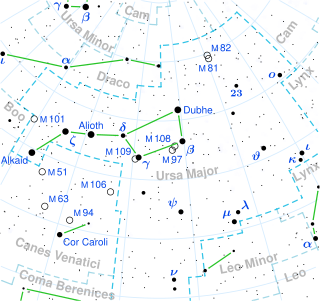
65 Ursae Majoris, abbreviated as 65 UMa, is a star system in the constellation of Ursa Major. With a combined apparent magnitude of about 6.5, it is at the limit of human eyesight and is just barely visible to the naked eye in ideal conditions. It is about 760 light years away from Earth.

AB Andromedae is a binary star in the constellation Andromeda. Its maximum apparent visual magnitude is 9.49 but shows a variation in brightness down to a magnitude of 10.46 in a periodic cycle of roughly 8 hours. The observed variability is typical of W Ursae Majoris variable stars, so the two stars in this system form a contact binary.
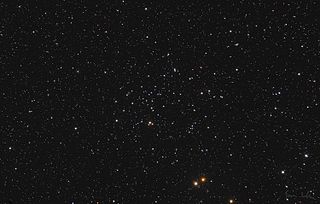
QX Andromedae is an eclipsing binary in the constellation Andromeda. It varies from a maximum apparent visual magnitude of 11.28 to a minimum of 11.50. Since it is impossible to specify the onset time of the eclipses, it is classified as a W Ursae Majoris variable star. It is also observed as an X-ray source and is a member of the open cluster NGC 752.
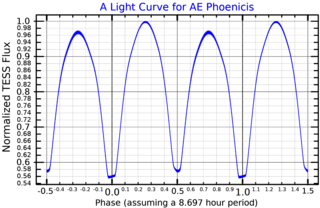
AE Phoenicis is a variable star in the constellation of Phoenix. An eclipsing binary, its apparent magnitude has a maximum of 7.56, dimming to 8.25 during primary eclipse and 8.19 during secondary eclipse. From parallax measurements by the Gaia spacecraft, the system is located at a distance of 168 light-years from Earth.

V752 Centauri is multiple star system and variable star in the constellation of Centaurus. An eclipsing binary, its apparent magnitude has a maximum of 9.10, dimming to 9.66 during primary eclipse and 9.61 during secondary eclipse. Its variability was discovered by Howard Bond in 1970. From parallax measurements by the Gaia spacecraft, the system is located at a distance of 410 light-years from Earth.

TX Ursae Majoris is an eclipsing binary star system in the northern circumpolar constellation of Ursa Major. With a combined apparent visual magnitude of 6.97, the system is too faint to be readily viewed with the naked eye. The pair orbit each other with a period of 3.063 days in a circular orbit, with their orbital plane aligned close to the line of sight from the Earth. During the primary eclipse, the net brightness decreases by 1.74 magnitudes, while the secondary eclipse results in a drop of just 0.07 magnitude. TX UMa is located at a distance of approximately 780 light years from the Sun based on parallax measurements, but is drifting closer with a mean radial velocity of −13 km/s.

UX Ursae Majoris is an Algol type binary star system in the northern circumpolar constellation of Ursa Major. It is classified as a nova-like variable star similar to DQ Herculis, although no eruptions have been reported. Since its discovery in 1933, this system has been the subject of numerous studies attempting to determine its properties. The combined apparent visual magnitude of UX UMa ranges from 12.57 down to 14.15. The system is located at a distance of approximately 952 light years from the Sun based on parallax, and is drifting further away with a radial velocity of 112 km/s.

XY Ursae Majoris is a short period binary star system in the northern circumpolar constellation of Ursa Major. It is an eclipsing binary with a baseline apparent visual magnitude of 9.50. The system is located at a distance of 221.5 light years from the Sun based on parallax measurements, but is drifting closer with a radial velocity of −10 km/s. It has a relatively high proper motion, traversing the celestial sphere at the angular rate of 0.191″·yr−1.
BZ Ursae Majoris is a dwarf nova star system in the northern circumpolar constellation of Ursa Major. It consists of a white dwarf primary in a close orbit with a red dwarf. The latter star is donating mass, which is accumulating in an accretion disk orbiting the white dwarf. The system is located at a distance of approximately 505 light years from the Sun based on parallax measurements.

EQ Tauri is a triple star system in the equatorial constellation of Taurus that includes a contact eclipsing binary. The system is too faint to be viewed with the naked eye, having a baseline apparent visual magnitude of 10.5. During the primary eclipse, the brightness of the system drops to magnitude 11.03, then to 10.97 during the secondary minimum. The secondary eclipse is total. Based on parallax measurements, it is located at a distance of approximately 730 light years from the Sun.



















